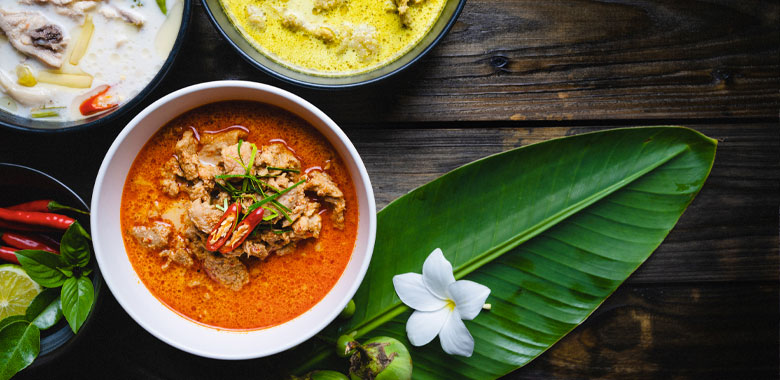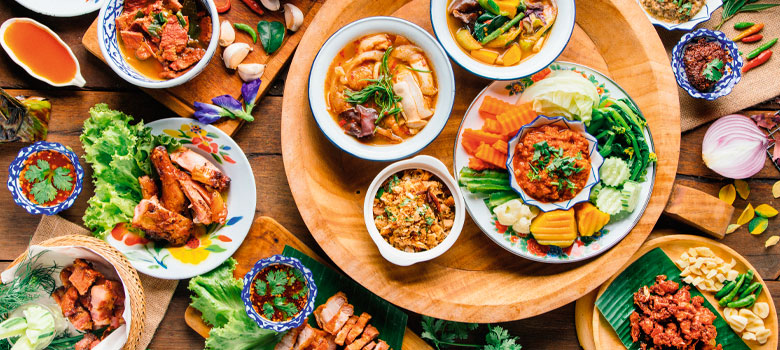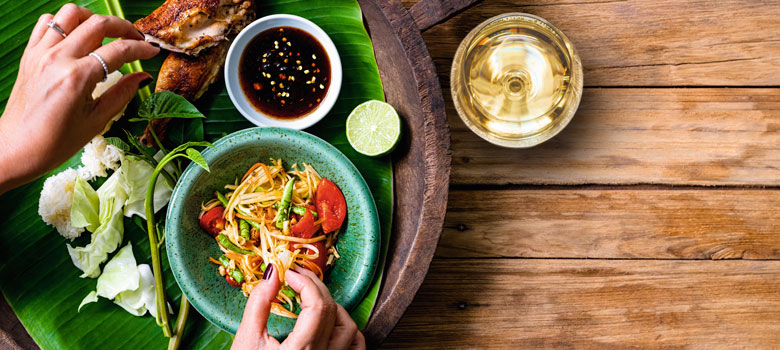
Food
Thai-vergence with Oriental Merchants
Is there a cuisine more exciting than Thai when it comes to food and wine pairing? Its varying NUANCES of sour, sweet, salt and heat make for a complex, yet rewarding balancing act that can transport your tastebuds to another dimension.
For European cuisine, the conundrum of wine pairing is a reasonably straightforward path to navigate. The classics – French, Italian, Spanish etc. – all have symbiotic wine developed in unison over centuries, that lay out a simple starting point; what grows together, goes together.
This approach goes out the window when it comes to Asian cuisines, which have had no such vinous co-conspirators during their evolutions. Australia loves Thai food. We fell for its exotic harmony of spice, sugar and acid, heady aromatics and provocative textures when it started appearing on our plates 30+ years ago – but what wines are best enjoyed with it?
Thai-Popular
Since the late 80s, Thai restaurants have gone from obscurity to be the third most popular (18%), just behind Chinese (24%) and Italian (20%). Thai-style curries, stir-fries, soups and salads are now as much a part of our weekly repertoire as spag bol. Wine too has followed a similar trajectory since that time; we love exploring wine as much as we love exploring cuisines, and as our palates and tastes become more sophisticated over time, so do the varietal and stylistic choices available for us to play with and explore.
Just like the majority of Southeast Asian cuisines, Thai food has a range of influences that can have a major impact on the elements framing what will – and what won’t – work as a wine match. There are some classic, tried and tested “go-to” options for the everyday Thai classics that will get you started, but when it comes to choosing wine for a range of dishes, or when cooking at home, having a base understanding of Thai cuisine and wine-matching principles will help you explore, experiment, and elevate your Thai and wine experience.

Understating Thai
Traditional Thai cuisine loosely falls into four categories that will help you understand its textures: tom (boiled dishes), yam (spicy salads), tam (pounded foods), and gaeng (curries). From there, where the dish comes from is important in determining levels of sweetness, sour, and heat.
Central Thai cuisine is the most popular and also the most diverse. Popular because it’s milder and has the least amount of spice-dominated dishes, and diverse because of its proximity to one of the main agricultural areas. Classic central dishes are green and red curry, massaman curry, and panang beef curry.
Northern, or ‘Lanna’ food, has influences from Myanmar (Burma), Laos and even China. ‘Lanna’ means ‘Kingdom of a Million Rice Fields’ and glutinous ‘sticky’ rice (not Jasmine) is served with almost every meal. Dishes from the north tend to be mild with a very low spice influence, and tend to have an oily component. Northern dishes are usually uncomplicated, are simple to prepare, and are generally served on platters for communal eating. Staples include jungle curry, spicy pork salad (larb), spicy fish salad, pork in banana leaf, fish and mango salad, and khao soi, a creamy, curry noodle soup.
Dishes from the North East corner are spicy, salty and heavily influenced by Thailand’s Laotian neighbours, who favour herbs over chillies for the kick. North East cuisine is popular and has an extra umami dimension from the addition of fish sauce, fermented fish, fish paste and salt. Sticky rice is generally served at each meal, and the recipes make use of the plentiful vegetables available there. North East standards are spicy pork salad and roast rice, marinated grilled pork, cucumber salads with fermented fish stock, fried pork jerky, fried curries, pork patties and grilled beef with dipping sauce.
Southern cuisine is shaped by seafood and Thailand’s Malaysian neighbours, and characterised by a strong, fragrant character due to the seafood and the herbs that define this region. Heat and spice are the main features of southern cuisine, with the liberal use of birds-eye chillies, dried chillies and pepper. The salty flavours come from shrimp paste and the sour flavours come from tamarind, garcinia (palm fruit) and lime.
The flavours from the south are strong, with many dishes and curries carrying a yellow colour due to the wide use of turmeric.
Southern classics are: sour fish curry, satay (pork or chicken), steamed fish and lemongrass, stir-fried pork and prawn with beans and shrimp paste, southern minced fish curry, sour yellow fish curry with bamboo and pineapple, and stir-fried pork with green peppercorns.

Balance, Weight, Contrast and Heat
All good wine matches must create harmony in the mouth, but there are a few ways to get there. Start with the weight of the dish and think about a wine that will sit comfortably with the weight and intensity of the dish – perhaps a light fragrant salad with a light crisp white, or a medium-bodied white for a creamy tom yum.
Next, look to create a balancing contract between flavours and textures: the crisp acicity of a young white will cut through and enhance coconut sauce, and a simple dish can be contrasted and enhanced with a complex white. Heat can be diffused and balanced by wines that have pronounced fruit and sugar sweetness, while wines with creamy textures will always be great for dishes with acidity and heat.
Salt
Salt loves acid, but is also a magnifying ingredient. Be wary of wines that are high in tannins or oak, as they may clash unpleasantly and amplify the alcohol flavours present in your wine, diminishing your enjoyment of each.
Red + Tannin = Caution
Spicy dishes can accentuate the tannins and alcohol in red wine and intensify the heat of the food. When thinking about red wines for Thai food, start with the weight-to-weight principle, think about the fruit of the wine, and go from there. Savoury reds will always win over fruit-forward wines, as will wines with softer textures. Think massaman beef curry with a cool-climate Shiraz that has a couple of years behind it.
Go-to All-rounders
Some classic Thai-friendly varieties will work well across the board and take a lot of guesswork out of the equation. Riesling, of any style and origin, will always be the #1 for fuss-free Thai food matching. The exotic aromatics and creamy texture of Pinot Gris and Gewürztraminer will also pair well. Chenin Blanc, Chardonnay, Vermentino, Grüner Veltliner, Fiano and Verdelho are all winning choices. For reds, always head towards savoury, 1–2 year–old Shiraz, Merlot, Sangiovese, Barbera, Cabernet Franc, Tempranillo and Gamay.
As ever, let your palate be your ultimate guide. Good luck, and happy experimenting!